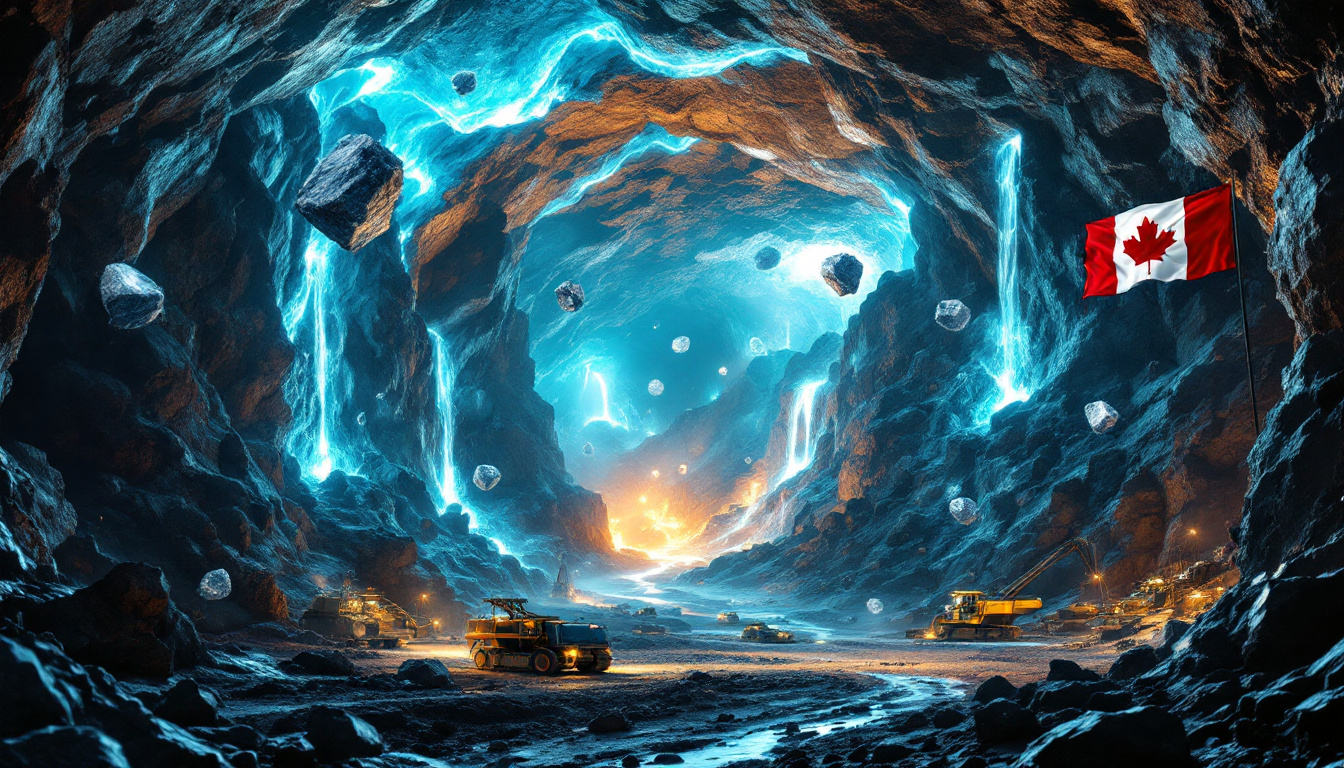Metamorphism of Ore Deposits: Understanding Impact on Mineral Resources
What is Metamorphism in the Context of Ore Deposits?
Metamorphism of ore deposits refers to the physical and chemical changes that occur in mineral deposits when they are subjected to increased heat, pressure, and chemical activity over geological time. These processes can significantly alter the grade, mineralogy, and structure of ore bodies, affecting their economic viability and exploration potential.
The transformation typically occurs when pre-existing rocks containing mineral concentrations are subjected to conditions different from those in which they originally formed. These changes can range from subtle mineralogical adjustments to complete recrystallization and structural reorganization of the ore body.
The Metamorphic Spectrum: From Mild to Extreme
- Greenschist facies: Temperatures of 300-450°C and low to moderate pressure, characterized by minerals like chlorite, epidote, and actinolite
- Amphibolite facies: Temperatures of 450-700°C and moderate pressure, featuring minerals like hornblende and plagioclase
- Granulite facies: Temperatures exceeding 700°C and high pressure, with mineralogy dominated by anhydrous assemblages
Other specialized facies include zeolite and prehenite-pumelyite facies (very low grade), blueschist and eclogite facies (high pressure in subduction zones), and hornfels and sanidinite facies (contact metamorphism near intrusions).
Key Drivers of Metamorphic Change in Ore Bodies
- Tectonic forces creating pressure and deformation through mountain-building events
- Magmatic intrusions providing heat and sometimes contributing additional metals
- Deep burial increasing both temperature and pressure over millions of years
- Hydrothermal fluid circulation enabling chemical reactions and metal transport
According to recent studies, hydrothermal fluids are particularly essential to the formation and modification of deposits such as orogenic gold, where greenschist facies metamorphism creates ideal conditions for gold mobilization and concentration.
How Does Metamorphism Enhance Ore Deposits?
Understanding how metamorphism can benefit ore deposits is crucial for exploration geologists seeking high-grade targets in metamorphic terranes. Three primary mechanisms drive the enhancement of ore bodies during metamorphism.
Hydrothermal Upgrading and Metal Reconcentration
- Dissolution of metals in metamorphic fluids, with gold being particularly soluble in greenschist facies fluids
- Transport along structural pathways including faults, fractures, and foliation planes
- Redeposition in favorable structural and chemical traps, often at redox or pH boundaries
- Development of high-grade ore shoots at the intersection of structures
Research by Tomkins et al. (2007) demonstrated that gold solubility peaks under greenschist facies conditions, explaining why many of the world's largest orogenic gold deposits occur in rocks metamorphosed to this grade.
Mechanical Enrichment Through Deformation
- Differential deformation of soft sulfides versus harder host rocks
- Preferential development of shear zones in sulfide-rich areas
- Physical separation of high-grade and low-grade material through ductile flow
- Removal of harder, non-economic minerals like pyrite through preferential shearing
This mechanical sorting effect is particularly evident in deposits like Broken Hill, where lead-rich and zinc-rich zones have been separated through differential deformation, creating distinct ore lodes with optimized metallurgical characteristics.
Partial Melting Processes
- Begins at approximately amphibolite facies conditions for most sulfide assemblages
- Selective melting of low-temperature minerals (tellurides, sulfosalts, native metals)
- Formation of metal-rich melts that migrate into fractures and low-pressure zones
- Example: Native bismuth melting at 261°C and scavenging gold at the NICO deposit in Canada
The NICO deposit provides a spectacular example of this process, where gold grades were significantly upgraded through bismuth melting, creating distinctive gold-bismuth veins crosscutting earlier arsenopyrite mineralization.
What Negative Impacts Can Metamorphism Have?
While metamorphism can enhance ore deposits, it can also degrade their economic value through various mechanisms that challenge both exploration and mining efforts.
Dilution and Metal Loss
- Widespread leaching without focused redeposition dispersing values
- Dispersion of metals throughout larger rock volumes, reducing grade below economic thresholds
- Complete removal of valuable elements from the deposit through fluid escape
- Creation of challenging metallurgical conditions through fine-grained recrystallization
In some cases, up to 50% of the original metal content can be dispersed or lost during high-grade metamorphism if structural traps aren't present to focus reconcentration.
Structural Disruption
- Faulting and displacement making mining challenging and increasing dilution
- Example: Red Lake district with gold ore offsets of hundreds of meters
- Creation of discontinuous, hard-to-predict ore bodies requiring intensive drilling
- Development of complex fold patterns obscuring continuity and grade distribution
Mining engineers at Red Lake have noted that following ore zones through offset faults can add 20-30% to mining feasibility studies and resource evaluation compared to continuous ore bodies, significantly impacting project economics.
Unfavorable Mineralogical Changes
- Formation of minerals that are difficult to process, like refractory gold in arsenopyrite
- Changes in metallurgical characteristics affecting recovery rates
- Introduction of penalty elements (arsenic, antimony, mercury) affecting concentrate quality
- Increase in hardness through recrystallization, raising milling costs
These mineralogical transformations can turn what would have been a straightforward processing operation into one requiring specialized and costly techniques like pressure oxidation or bacterial leaching.
How Does Metamorphism Complicate Deposit Interpretation?
One of the most significant challenges with metamorphosed ore deposits is determining their original type and formation mechanisms, which is crucial for exploration targeting.
Obscuring Original Deposit Features
- Destruction of primary textures and minerals, particularly at amphibolite facies and above
- Overprinting of diagnostic characteristics used in genetic models
- Challenges in determining genetic models for effective exploration
- Loss of isotopic and geochemical signatures used for classification
Exploration geologists often debate metamorphosed deposits' origins for decades, leading to competing exploration models and strategies that can either accelerate or delay new discoveries.
Case Study: The Boliden Controversy
- Production history: 3.85 Moz gold, 12 Moz silver, 0.56 Mt arsenic, 0.12 Mt copper (1925-1966)
- Unusual features: High gold grades (15.9 g/t) about 10 times higher than typical VMS deposits
- Competing interpretations: Volcanogenic Massive Sulfide (VMS) vs. epithermal deposits: formation and economic significance
- Exploration implications: Different target models require fundamentally different strategies
Recent work by Mercier-Langevin et al. (2013) has reconciled these competing models by demonstrating a VMS origin with subsequent metamorphic upgrading of gold content through both fluid remobilization and structural focusing.
Case Study: Broken Hill's Complex History
- One of the world's largest lead-zinc-silver deposits (280 Mt at 10% Pb, 8.5% Zn, 148 g/t Ag)
- Granulite facies metamorphism with multiple deformation events creating complex geometry
- Current interpretation: Sedimentary Exhalative (SEDEX) deposit transformed by extreme metamorphism
- Unique mineralogy including over 200 mineral species, approximately 30 of which occur nowhere else
The century-long debate over Broken Hill's origin highlights how metamorphism can obscure primary features, with the deposit now recognized as a SEDEX system that underwent extraordinary metamorphic transformation.
FAQ: Understanding Metamorphosed Ore Deposits
At what metamorphic grade do ore deposits begin to melt?
Most sulfide minerals begin partial melting well into amphibolite facies, though some low-melting-point minerals like tellurides and native bismuth can melt at lower temperatures. Bismuth melts at only 261°C, while galena (PbS) begins melting at approximately 600°C under certain pressure conditions.
Can completely barren rock become ore through metamorphism?
While metamorphism generally redistributes existing metals rather than creating new ones, in rare cases, it can concentrate previously uneconomic dispersed mineralization into viable deposits. This process typically requires pre-existing anomalous metal content and favorable structural conditions for focusing.
How do exploration strategies differ for metamorphosed deposits?
Exploration in metamorphic terranes requires greater emphasis on structural controls, understanding rock deformation and Earth's dynamic crust, and recognition of transformed mineral assemblages. Companies exploring these terranes typically budget 20-30% more for drilling due to the complex geometry and discontinuous nature of the ore bodies.
Table: Comparison of Metamorphic Effects on Different Deposit Types
| Deposit Type | Positive Metamorphic Effects | Negative Metamorphic Effects | Key Indicator Minerals |
|---|---|---|---|
| VMS | Upgrading of gold content, structural focusing | Destruction of stratiform character | Staurolite, gahnite, garnet |
| Orogenic Gold | Enhanced fluid focusing in shear zones | Complex structural overprinting | Tourmaline, arsenopyrite |
| Porphyry | Potential upgrading of peripheral zones | Dispersion of central high-grade zones | Secondary biotite, K-feldspar |
| SEDEX | Coarsening of grain size, improved processing | Structural dismemberment | Metamorphic galena, sphalerite |
| Epithermal | Concentration of gold in structural traps | Loss of diagnostic textures | Adularia, sericite |
How to Evaluate Metamorphosed Ore Deposits for Investment
When considering investment in mining projects involving metamorphosed ore deposits, several key factors should be evaluated to assess both risk and potential.
Key Indicators of Potential Economic Enhancement
- Evidence of fluid focusing in structures like shear zones, fold hinges, and dilational jogs
- Separation of high-grade zones through deformation, creating enriched ore shoots
- Presence of remobilized high-value minerals in veins, fractures, or pressure shadows
- Coarse-grained recrystallization improving metallurgical performance
Projects demonstrating these characteristics often show grade improvements of 2-5 times over their unmetamorphosed equivalents, potentially offering superior economic returns.
Red Flags for Potential Value Destruction
- Widespread dispersion without reconcentration, leading to sub-economic grades
- Complex structural disruption without clear controls on ore location
- Mineralogical changes affecting processing, particularly refractory characteristics
- Extreme deformation creating multiple small ore lenses rather than coherent bodies
Investment analysis should include detailed metallurgical testing and structural modeling to understand how metamorphism has affected both grade distribution and processing characteristics.
Technical Considerations for Resource Evaluation
- Need for detailed structural analysis to understand ore controls and continuity
- Importance of understanding metamorphic history and its timing relative to mineralization
- Value of trace element studies for determining origin and potential for additional resources
- Requirement for specialized drilling approaches to address complex geometry
According to industry specialists, drilling density in metamorphosed terranes typically needs to be 30-50% higher than in unmetamorphosed equivalents to achieve the same level of resource confidence. This has significant implications for understanding the JORC code for informed mining investments.
Conclusion: The Dual Nature of Metamorphism in Ore Systems
Metamorphism represents both opportunity and challenge for mineral exploration and development. The same processes that can upgrade one deposit may destroy another, and the key to successful evaluation lies in understanding the specific metamorphic history of each mineral system.
The interplay between deformation, fluid flow, and mineralogical change creates a complex but potentially rewarding target for exploration. Companies that develop expertise in recognizing and interpreting metamorphic effects gain a significant advantage in both greenfield exploration and brownfield resource expansion.
As exploration increasingly focuses on complex geological terranes, particularly in ancient shield areas of Canada, Australia, and Africa, the ability to recognize and interpret metamorphic effects on economic ore deposits in layered complexes and kimberlites becomes increasingly valuable for resource companies and investors alike.
Emerging technologies like hyperspectral core scanning and machine learning-based structural interpretation are beginning to revolutionize our ability to decipher these complex systems, potentially unlocking resources that have remained hidden due to the obscuring effects of metamorphism.
Want to Be First to Know About the Next Major ASX Mineral Discovery?
Don't miss the next market-moving discovery announcement. Discovery Alert's proprietary Discovery IQ model instantly identifies significant ASX mineral discoveries, turning complex data into actionable investment opportunities. Explore how major discoveries can generate substantial returns by visiting our dedicated discoveries page.




